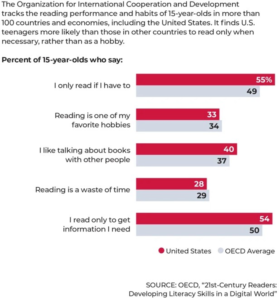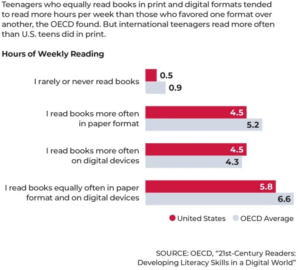 Successful readers develop not just the skill but the habit of reading. As a decline in pleasure reading coincides with a move to different modes of screen-based texts, experts worry students need more comprehensive support to become lifelong readers in the digital age.
Successful readers develop not just the skill but the habit of reading. As a decline in pleasure reading coincides with a move to different modes of screen-based texts, experts worry students need more comprehensive support to become lifelong readers in the digital age.
“There’s a lot of pressure on readers today to be able to select texts that are purposeful and useful and to discard others” in academic contexts, said Kristen Turner, a professor of teacher education at Drew University and the director of the Digital Literacies Collaborative, a professional network for teachers. “Then also to find those long-form texts that might allow them an escape or to learn something or to get another perspective … it can be overwhelming.”
That’s problematic, because developing the habit of long-form and pleasure reading is associated with significantly better academic achievement across subjects. Analyses of reading behavior and achievement data from both the National Assessment of Educational Progress and the Program for International Student Assessment show students who report reading for pleasure or that reading is one of their favorite pastimes have higher general reading achievement.
Yet the number of these students has fallen in the past decade.
“Around the world and in the U.S., people aren’t reading unless they have to; half of them are saying, ‘Don’t make me do this,’” said Naomi Susan Baron, a reading researcher and the author of the 2021 book
How We Read Now: Strategic Choices for Print, Screen, and Audio.
Similarly, the Pew Research Center’s annual survey of reading found in 2021 that nearly 1 in 4 U.S. adults said they hadn’t read a book in any format—print, electronic, or audio—in the past 12 months. More than 30 percent of those who earn less than $30,000 a year reported no book reading, compared with only 15 percent of those who made $75,000 annually who had not read a book in the last year.
Holding students’ attention
While multiple studies have found reading online can interfere with comprehension, this effect differs by age and text complexity: Young readers using simple, short texts have not seen a significant drop in comprehension, whether they were reading in print or online, while teenagers and adults, grappling with long-form and more complex texts, did find digital reading more challenging for comprehension and focus.
Baron and her colleagues found in studies across the United States and internationally, more than 80 percent of college-age students said they find it easier to concentrate on print rather than texts in other media, and more than 70 percent reported they find print easier to learn from and remember.
“Students tell me [in print] you’re able to lose yourself in the words and you can read forever without thinking about anything else. It’s an escape. Whereas if you’re reading digitally and if you have internet access, you cannot escape,” Baron said.
 One reason why: Both college students and, in a separate study, high schoolers said they are much more likely to multitask—read multiple texts, respond to email or social media, watch videos, and so on—when reading online versus in print. An analysis of more than a decade of research finds students comprehend less when they are reading online, in part because they think they are understanding the text they read better than they actually are.
One reason why: Both college students and, in a separate study, high schoolers said they are much more likely to multitask—read multiple texts, respond to email or social media, watch videos, and so on—when reading online versus in print. An analysis of more than a decade of research finds students comprehend less when they are reading online, in part because they think they are understanding the text they read better than they actually are.
Instead of getting lost in a story, students are more likely to get distracted, experience eyestrain, and become prone to stopping before finishing it. Over time, studies suggest that can become a habit that makes it harder to follow longer texts fluently and think deeply about what they read. NAEP data suggest
students who spend more screen-based reading time perform worse in reading in both grades 4 and 8.
New supports are needed to nurture a love of reading
Emerging research suggests children and adults alike have more difficulty reading online texts that require long focus or more than one sitting. Yet most teachers do not know how to nurture a love of reading, particularly longer texts, in students outside of traditional print, according to Turner.
“Even the new teachers are part of a generation that was actually taught to read and write almost entirely in print. A lot of the research that’s been done [on reading long texts on different modes] has been done with college students or even older high school students who were never taught how to read on a screen or to annotate on a screen or to engage deeply with text on a screen,” said Drew University’s Turner. “It seems like a small shift, but it’s actually a huge shift in how we think about teaching reading.”
To build better reading habits in new platforms, experts recommended educators focus on:
Streamlining: Close other applications while reading, such as email or other websites, and encourage students to read through a text completely before going back to follow hyperlinks. Unlike print footnotes, it can be easier to get sucked into long detours from online links.
Noting: Most long digital text formats include annotation and collaboration tools, which can help students engage more deeply with the work—if the tools are of high quality and students learn to use them regularly.
Building stamina: Particularly in digital text, taking breaks can reduce eyestrain and improve focus. But students also should be encouraged to build up the time they read challenging text.
Helping students build these skills can pay off in building better reading habits in and out of school. Melissa Jacobs, the director of library services for the New York City public schools, the nation’s largest school library system, said one silver lining of the pandemic is that it has forced schools and students alike to develop more comfort in switching among print, digital, and audio books. In the last two years, she said the overall time students have spent on library titles increased with the addition of online and audio versions expanded in response to remote learning needs.
“Over the next few years, I think that students are going to be able to develop a skill set that will allow them to self-select the format as a reader,” she said. “I think what I would like to see happen is that the student is able to differentiate and decide that, ‘I want to read this book as an audio book. I want to read that book as a print book. I want to read this book as an e-book.’ “I would love the opportunity to provide as many formats as possible, as many mediums as possible, so that students have access and there’s equity and they can differentiate what really makes a difference for them as an independent reader.”
Building a sense of autonomy can help students develop a passion for reading that will carry them into adulthood, Jacobs said. “[Teachers] can’t just say, ‘You must read this and it’s going to be your pleasure- reading book.’ Adults find things that we like, and if we don’t like it, we abandon it. Abandonment should be OK to help students become readers for pleasure.”
Article originally published in Education Week

Follow Us On Social